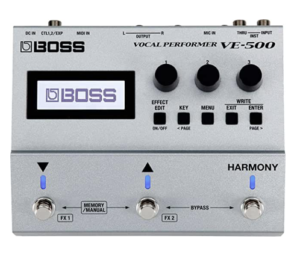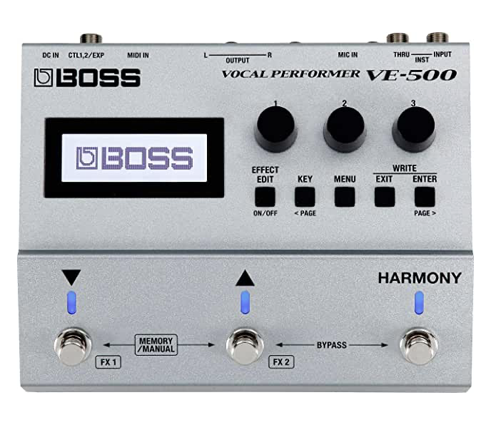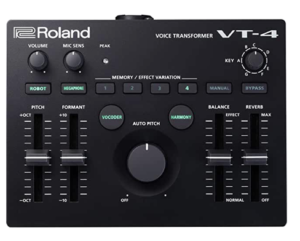The BOSS VE-500 Vocal Performer is a versatile vocal effects processor and harmonizer designed for singers and vocalists. It’s produced by BOSS, a well-known brand in the music industry for their high-quality guitar pedals and audio equipment.
Vocal Effects
 The BOSS VE-500 Vocal Performer [buy here] offers a wide range of vocal effects to enhance and manipulate your vocal sound. Please note that specific features and effects may vary based on firmware updates or new releases. Here are some of the vocal effects that were commonly available in the BOSS VE-500:
The BOSS VE-500 Vocal Performer [buy here] offers a wide range of vocal effects to enhance and manipulate your vocal sound. Please note that specific features and effects may vary based on firmware updates or new releases. Here are some of the vocal effects that were commonly available in the BOSS VE-500:
- Reverb: Various reverb algorithms to add ambience and space to your vocals, including room, hall, plate, and more.
- Delay: Different delay types such as digital, analog, tape, and modulated delays for creating echoes and spatial effects.
- Harmony: Real-time harmony generation with adjustable intervals to create rich vocal harmonies.
- Pitch Correction: Pitch correction algorithms to help you stay in tune and achieve a polished vocal performance.
- Modulation Effects: Effects like chorus, flanger, and phaser to add depth and movement to your vocals.
- Distortion/Overdrive: For adding grit and character to your vocals, creating effects ranging from subtle saturation to full-blown distortion.
- EQ: Equalization controls to shape the tonal balance of your vocals.
- Doubling: Simulates the effect of double-tracked vocals for a thicker sound.
- Formant Shifting: Alters the vocal formants to create unique vocal textures and tonal changes.
- Filter Effects: Filters such as high-pass, low-pass, and band-pass filters for creative sound shaping.
- Vocoder: A classic effect that blends your voice with synthesized tones, allowing you to create robotic or synthesized vocal sounds.
- Panning: Adjusts the stereo placement of your vocal within the mix.
- Compressor/Limiter: Controls to even out the dynamics of your vocals and control volume levels.
- Looper: Looping capabilities for layering vocal parts and creating live vocal arrangements.
- MIDI Control: Allows you to integrate the VE-500 with other MIDI devices for synchronized control and automation.
- Expression Pedal Control: Some versions of the VE-500 include an expression pedal input for real-time control over various parameters.
9 Best Vocal Effects Pedals for 2023
How to isolate vocals from a song
Best Amp for Acoustic Guitar: 7 Great Options
Guitar Chord Finder: Ultimate Tool
Harmonies
One of the standout features of the VE-500 is its ability to generate harmonies in real-time. You can set the harmonies to follow your singing with specific intervals (thirds, fifths, etc.), adding depth and richness to your vocals. This is particularly useful for creating lush vocal arrangements without needing backup singers.
 The harmonies feature in a vocal effects processor, such as the BOSS VE-500 Vocal Performer, allows you to generate additional vocal notes that complement and harmonize with your original singing voice. It essentially creates the effect of having multiple voices singing in harmony with you, even if you’re singing alone. This feature can add depth, richness, and complexity to your vocal performances.
The harmonies feature in a vocal effects processor, such as the BOSS VE-500 Vocal Performer, allows you to generate additional vocal notes that complement and harmonize with your original singing voice. It essentially creates the effect of having multiple voices singing in harmony with you, even if you’re singing alone. This feature can add depth, richness, and complexity to your vocal performances.
Here’s how the harmonies feature works and how it can be used:
- Real-Time Harmony Generation: The harmonies feature analyzes the pitch and melody of your singing in real-time. It then generates harmonized vocal lines that follow your lead voice according to preset intervals (e.g., thirds, fifths, octaves, etc.).
- Interval Selection: Most harmonizer effects allow you to choose the interval at which the harmonies are generated. For example, you can set the harmonies to be a third above or a fifth below your original vocal line.
- Chord Changes: Some harmonizers can also analyze the underlying chords of the music you’re singing over and adjust the harmonies accordingly. This creates a more musically pleasing result, especially if you’re singing over chord changes.
- Manual Control: Depending on the harmonizer, you might have the ability to manually control the harmonies using footswitches, expression pedals, or MIDI controllers. This allows you to switch harmonies on and off, change intervals, or create dynamic shifts in your vocal arrangement.
- Layering and Texture: The harmonies feature is excellent for creating vocal textures and layering. It can simulate the effect of having backup singers or a choir, adding a fuller sound to your vocal performance.
- Live Performance: In a live performance setting, the harmonies feature can help you achieve complex vocal arrangements without needing additional singers. This is particularly useful for solo artists or small groups.
- Studio Recording: Harmonizers are also commonly used in the studio to create lush vocal harmonies in multi-track recordings. It allows artists to experiment with different harmonies and vocal arrangements.
- Creative Effects: While traditionally used for creating harmonies, some harmonizers can also be used creatively to generate unique vocal effects that go beyond natural harmonies. This can lead to experimental and artistic vocal textures.
The harmonies feature in a vocal processor like the BOSS VE-500 can greatly expand your vocal capabilities and open up new creative possibilities.
Creating Loops
 The VE-500 allows you to create vocal loops, enabling you to layer multiple vocal parts or create intricate vocal textures. This feature can be a great tool for live performances or studio recordings.
The VE-500 allows you to create vocal loops, enabling you to layer multiple vocal parts or create intricate vocal textures. This feature can be a great tool for live performances or studio recordings.
Creating loops in the BOSS VE-500 Vocal Performer involves using its looping functionality to record and play back vocal parts. Loops are useful for layering vocals, creating harmonies, and adding depth to your live performances or recordings. Here’s a general guide on how to create loops using the VE-500:
- Enter Loop Mode:
- Press the “Looper” button on the VE-500 to enter the looping mode. This activates the looper and prepares it for recording.
- Start Recording:
- Press the “Record” button to begin recording your vocal part. The VE-500 will start recording your voice.
- Sing or Perform:
- Perform your vocal part while the VE-500 records it. Make sure you stay in time with any metronome or rhythm settings you’ve configured.
- End Recording:
- Press the “Record” button again to stop recording. The recorded vocal part will start playing back in a loop.
- Overdub (Optional):
- If you want to layer additional vocals over the existing loop, press the “Overdub” button. This will let you record another vocal part while the initial loop continues to play.
- Stop Looping:
- Press the “Record” button again to stop overdubbing and end the loop. The looped vocal parts will continue playing back.
- Adjust Loop Length:
- Depending on the VE-500’s capabilities, you might be able to adjust the loop’s start and end points to create shorter or longer loops.
- Adjust Volume and Effects:
- While the loop is playing, you can adjust the volume of the looped vocals and apply effects (such as reverb, delay, harmonies, etc.) to the looped sound.
- Exit Loop Mode:
- Press the “Looper” button again to exit the looping mode. This will stop the loop playback.
- Save or Clear Loops:
- Some looping features allow you to save loops for future use. Check the VE-500’s manual to understand how to save and manage your loops. You may also have the option to clear or delete loops you no longer need.
 Other Features
Other Features
- Easy Editing and Presets: The pedal offers an intuitive interface for editing and creating presets. You can adjust effects parameters, harmonies, and other settings on the fly. Additionally, the pedal likely includes a variety of preset sounds that you can use as starting points for your own vocal effects.
- Connection Flexibility: The VE-500 [buy here] is designed to integrate seamlessly into your live or studio setup. It provides various inputs and outputs for connecting microphones, instruments, mixers, PA systems, and more. This flexibility allows you to tailor your vocal sound to different performance environments.
- MIDI Control: The pedal may offer MIDI connectivity, allowing you to sync it with other MIDI-compatible devices and control various parameters remotely.
- Build Quality: BOSS is known for its durable and roadworthy construction. The VE-500 is likely built to withstand the rigors of live performances and touring.
- Expression Pedal: Some versions of the VE-500 might include an expression pedal input, which can be used to control parameters in real-time, such as adjusting effect levels or manipulating harmony settings.

